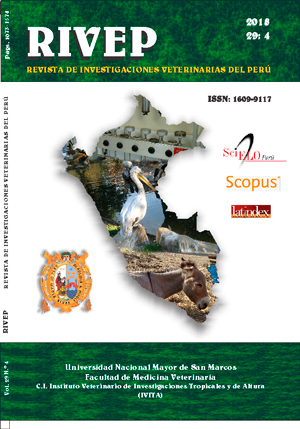Seroprevalence and risk factors of bovine neosporosis in the valley in the Mantaro Valley, Junín, Peru
DOI:
https://doi.org/10.15381/rivep.v29i4.15195Keywords:
Mantaro Valley, bovine neosporosis, prevalence, risk factorsAbstract
The seroprevalence of bovine neosporosis in dairy herds in four provinces of the Mantaro Valley, Peru and the main risk factors involved, through the ELISA test were determined. Blood samples were taken from 425 animals in 37 herds and an epizootic survey was applied in parallel. The general sample prevalence for bovine neosporosis was 15.3%, the prevalence per herd was 12.8% and the herd prevalence was 56.8%, without significant differences between provinces. The massive and constant presence of rats (OR: 18,417), inadequate health management (OR: 7.5) and inadequate personnel management (OR: 12.75) were identified as risk factors for the presentation of neosporosis. An association was found between high prevalence of neosporosis with the presence of repeat breeder cows in the herd, with cases of abortions and anomalous births, and with the use of water from ditches and wells for drinking.Downloads
Downloads
Published
Issue
Section
License
Copyright (c) 2018 Fernando Arauco Villar

This work is licensed under a Creative Commons Attribution-NonCommercial-ShareAlike 4.0 International License.
AUTHORS RETAIN THEIR RIGHTS:
a. Authors retain their trade mark rights and patent, and also on any process or procedure described in the article.
b. Authors retain their right to share, copy, distribute, perform and publicly communicate their article (eg, to place their article in an institutional repository or publish it in a book), with an acknowledgment of its initial publication in the Revista de Investigaciones Veterinarias del Perú (RIVEP).
c. Authors retain theirs right to make a subsequent publication of their work, to use the article or any part thereof (eg a compilation of his papers, lecture notes, thesis, or a book), always indicating the source of publication (the originator of the work, journal, volume, number and date).










